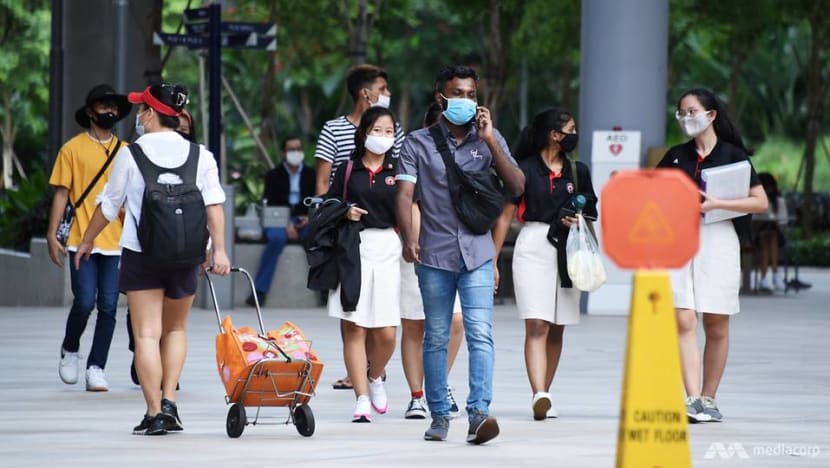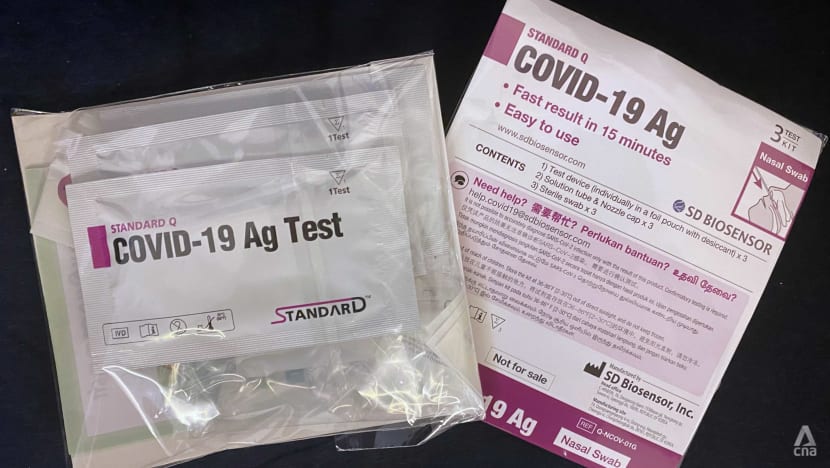Singapore
FAQ: What you need to know about COVID-19 quarantine orders, health risk warnings and alerts
People with masks on at Paya Lebar Quarter on Jul 15, 2020. (Photo: Try Sutrisno Foo)
 Cindy Co
Cindy Co
23 Sep 2021 06:20AM (Updated: 23 Sep 2021 06:02AM)
SINGAPORE: The Ministry of Health (MOH) announced on
Sep 6 that it would begin issuing health risk warnings and health risk alerts as part of new measures to contain the spread of COVID-19, amid a sharp spike in the number of local cases.
On top of quarantining close contacts, these new measures will enable authorities to “cast a wide net” whenever a new cluster is detected, and help contain them quickly, said MOH.
Singapore has seen a sharp spike in the number of local COVID-19 cases, with the daily caseload on Sep 18
crossing the 1,000-mark for the first time since April last year.
The country has taken multiple steps to contain the spread as it moves towards living with the virus as an
endemic disease.
On Friday, Health Minister Ong Ye Kung said that every country that decides to live with the virus will have to undergo a “major wave of transmission”.
“This is almost like a rite of passage, before humans and the virus achieve a new equilibrium and things stabilise,” he said.
To be able to "live with COVID-19 as an almost endemic disease", said Mr Ong, measures such as vaccination, treatment, mask-wearing and testing will have to be implemented in tandem.
"Take away any portion, any part, any component and I think we can’t be successful," he said.
Singapore on Tuesday reported 1,173 new local COVID-19 infections and three fatalities. As of Tuesday, the country has reported a total of 79,899 COVID-19 cases and 65 deaths from the disease.
Here is what you need to know about quarantine orders, health risk warnings and health risk alerts.
Q: What are health risk warnings and health risk alerts?
Health risk warnings are issued to those identified as close contacts of COVID-19 cases, based on TraceTogether and SafeEntry data.
People who have been in close proximity with a COVID-19 case for an extended period of time will also receive a health risk warning.
Meanwhile, health risk alerts are issued to people with possible exposure to COVID-19.
According to MOH’s website, people issued health risk alerts are those who have “directly or indirectly been exposed to the risk of infection, even if that risk is lower than that of a close contact”.
Antigen Rapid Test self-test kits mailed out by MOH on Aug 28, 2021.
Q: What do I need to do if I receive a health risk warning?
People issued with health risk warnings must comply with the testing and isolation requirements by law.
Once they are notified by MOH, they should book an appointment for a polymerase chain reaction (PCR) test within 48 hours of the SMS. This can be done at either a private practitioner or a swab-and-send-home clinic, not including polyclinics.
They also have to self-isolate until their PCR test result comes back negative. This means that they should not leave their residence except to seek medical treatment from a doctor, or to go for their PCR tests.
People who have been issued with health risk warnings are also “strongly advised” to stay in their rooms and minimise interaction with others in the household or visitors during this period, said MOH on its website.
They may only end their self-isolation once they receive a negative PCR test result, but should continue to minimise social interactions as much as possible for the entire period.
On the third, fifth and seventh day from the last exposure, they should perform a self-test with an antigen rapid test (ART), which can be collected from ART vending machines.
A second PCR test should be done on the eighth day from the last exposure. MOH's SMS notification will contain the date for the second PCR test appointment.
Q: What do I do if I receive a health risk alert?
Those who receive health risk alerts should monitor their health and seek medical attention if they are unwell within the health risk alert period, said MOH on its website.
They should undergo a self-administered ART within 24 hours from the last date of exposure, as well as on the third and fifth day. These kits can be collected from ART vending machines.
MOH also said that those who have been issued health risk alerts are “strongly encouraged” to come forward for free swab tests.
Q: Can I leave the house?
Those under health risk warnings must self-isolate immediately after receiving the SMS notification. They must comply with the self-isolation requirements by law.
Their isolation only ends when they receive a negative PCR test or at the end of their health risk warning period, whichever is earlier.
Those under health risk alerts do not need to self-isolate. However, they should minimise social interactions as much as possible during the alert period, work from home if possible and only go to their workplace if absolutely necessary, said MOH on its website.
Those under health risk warnings and health risk alerts cannot claim compensation for time lost at work.
Antigen tests can return results within half an hour, as compared to PCR tests which take at least a day. (Photo: Ministry of Manpower)
Q: How do health risk warnings and alerts differ from a quarantine order?
Health risk alerts are issued only to people with possible exposure to the COVID-19 virus.
While health risk warnings and quarantine orders are both issued to close contacts of COVID-19 cases, those under quarantine orders have to self-isolate for the entire duration of the order.
People who are issued with health risk warnings can end their self-isolation after they receive a negative PCR test result. However, it is still recommended that they minimise social interactions for the duration of the health risk warning.
Q: What do I need to do if I receive a quarantine order?
People are issued with quarantine orders if they are, or are suspected to be, a carrier of the COVID-19 virus. Close contacts of a COVID-19 case may also be issued with quarantine orders.
Quarantine orders can be served at home, a dedicated Government quarantine facility or in hospital. This will be determined by MOH based on the person’s contact history, state of health and suitability of their home.
People whose household members have not been issued quarantine orders will be sent to a Government quarantine facility.
Those under quarantine must not leave their quarantine location for any reason, even to carry out daily activities. For urgent matters that must be conducted in-person and cannot be postponed, the individual has to seek permission from the quarantine order agent.
Spot checks will be conducted throughout the quarantine period.
There will be a swab test performed at the start of the quarantine period and another swab test performed near the end of the order.
These tests are arranged by appointment only and are conducted at designated testing sites. Two-way transportation will be provided.
Self-employed Singaporeans or permanent residents under quarantine can apply for a quarantine order allowance of up to S$100 a day. Singapore-registered companies whose employees - Singapore citizens, permanent residents and workpass holders - are served quarantine orders can also apply for the allowance.
Approved caregivers of a person under quarantine may apply for the allowance as well, subject to eligibility.
/fig-3-(22-sep).jpg?sfvrsn=cb9feafd_0)

/fig-1-(22-sep).jpg?sfvrsn=80819f69_0)
/fig-2-(22-sep).jpg?sfvrsn=648ed51_0)






